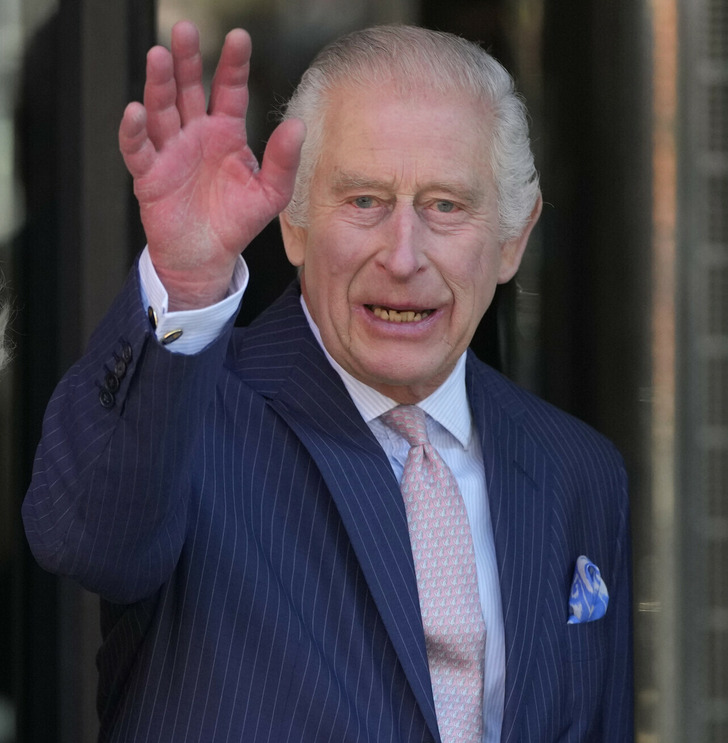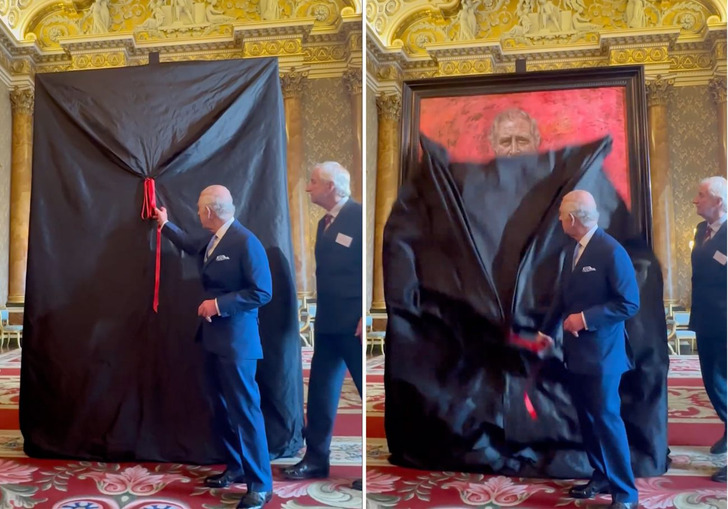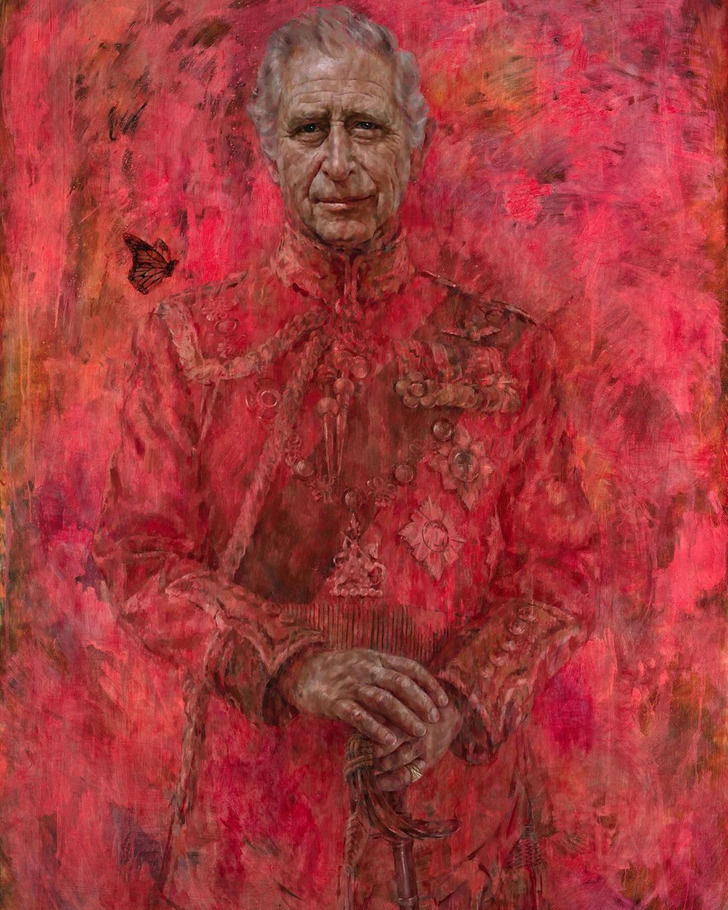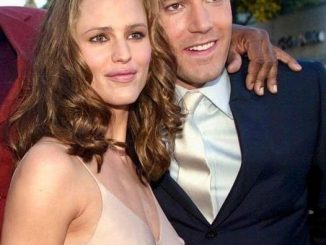In a dramatic unveiling that has left the public and critics buzzing, King Charles III revealed his first official portrait since ascending to the throne, and reactions have been anything but tepid. As debates rage on social media and in art circles, it is clear that King Charles’ portrait is destined to be one of the most talked-about royal artworks in recent history.
The unveiling

Recently, King Charles III personally unveiled a new portrait of himself at Buckingham Palace, the first such portrait since his coronation. The Royal Family’s Instagram account shared an exclusive video of the unveiling, featuring the king himself presenting the artwork.
This significant new work will ultimately be displayed in Drapers’ Hall in London, adding to its historical art collection and offering the public a glimpse of the monarch’s regal presence.
There was an ongoing debate in the comments.

The unveiling sparked a heated debate in the comments section on the Royal Family’s Instagram post and other social media sites. Opinions were sharply divided, with some users harshly criticizing the artwork. Comments ranged from “That is hideous” and “Without sounding rude, this is the worst royal portrait I’ve ever seen” to “100% thought this was satire.”
One critic remarked, “The face is good, the rest is appalling,” while another noted, “I would have loved this if it was any other color than red. He really captured the essence of him in the face, but the harshness of the red doesn’t match the softness of his expression.”
Despite the criticism, there were also voices of appreciation, such as “A lovely portrait of King Charles! I love the way the muted background draws attention to his face!” The mixed reactions highlight the polarizing nature of the portrait and the strong emotions it has evoked among the public.
The artist
Jonathan Yeo, a prominent figure in the world of figurative painting, has earned widespread acclaim for his unique blend of traditional and experimental portraiture. Yeo’s distinctive approach involves a deep engagement with his subjects, allowing him to capture their essence beyond mere physical appearance.
His recent portrait of King Charles III epitomizes this philosophy. Yeo explained, “As a portrait artist, you get this unique opportunity to spend time with and get to know a subject, so I wanted to minimize the visual distractions and allow people to connect with the human being underneath.”
The meaning of the portrait.
A particularly striking element of Yeo’s portrait is the inclusion of a butterfly. This detail serves multiple purposes, both symbolic and compositional. Yeo elaborated, “Primarily a symbol of the beauty and precariousness of nature, it highlights the environmental causes the King has championed most of his life and certainly long before they became a mainstream conversation.”
The butterfly also provides a visual contrast to the uniform, softening the portrayal and adding layers of meaning. “In the context of art history, a butterfly often symbolizes metamorphosis and rebirth, paralleling the King’s transition from Prince to monarch during the period the portrait was created,” Yeo noted, further emphasizing the transformative phase in King Charles’s life.

Yeo expressed his gratitude and honor for being commissioned to create such a significant portrait. “It was a privilege and pleasure to have been commissioned by The Drapers’ Company to paint this portrait of His Majesty The King, the first to be unveiled since his Coronation.”
Yeo’s approach to portraiture aims to encapsulate the life experiences and humanity etched into his subjects’ faces. “I do my best to capture the life experiences and humanity etched into any individual sitter’s face, and I hope that is what I have achieved in this portrait,” he explained.
The challenge of portraying a figure as complex and significant as King Charles III was substantial, but one that Yeo found immensely rewarding. “To try and capture that for His Majesty The King, who occupies such a unique role, was both a tremendous professional challenge, and one which I thoroughly enjoyed and am immensely grateful for,” he concluded. The portrait, destined for Drapers’ Hall in London, stands as a testament to both the artist’s skill and the monarch’s enduring legacy.
Discover the lesser-known facets of King Charles III’s life in our compelling article, “8 Things About King Charles III That Will Allow Us to Know Him More Closely.” Dive beyond the regal exterior to uncover intimate details about his passions, personal experiences, and unique quirks.
Preview photo credit Kin Cheung / Associated Press / East News, theroyalfamily / Instagram, jonathanyeo / Instagram
Five years after divorce, Brad Pitt, 60, is living with his new girlfriend – and i’m sure you will recognize her
Brad Pitt and girlfriend Ines de Ramon have taken the next step in their romance after moving in with each other, according to sources.
The coupIe were rumored to be an item as far back as November 2022, by which time reports suggested they had been dating for “a few months”. In recent times their relationship has been speculated about more concretely in the media, with Brad and Ines said to have celebrated the former’s 60th birthday in Paris.
It now appears there can be no doubting that the pair are ready and willing to commit their lives to one another, with PEOPLE claiming that de Ramon has moved into Pitt’s home.
The last few years have been tricky for Pitt where Iove is concerned. The actor’s marriage to Angelina Jolie ended in a tumultuous separation, the wounds of which still don’t appear to have fully healed. Famously dubbed ‘Brangelina’ in the media, the A-listers fell in love on the set of Mr. and Mrs. Smith, embarking on a romance that stole headlines all over the world.
In 2016, however, Jolie filed for divorce, citing irreconcilable differences. She also moved to request sole custody of the pair’s six chiIdren, Maddox, Pax, Shiloh, Zahara, Vivienne and Knox.
LAS VEGAS, NEVADA – NOVEMBER 17: Brad Pitt, star of the upcoming Formula One based movie, Apex, walks in the Pitlane prior to qualifying ahead of the F1 Grand Prix of Las Vegas at Las Vegas Strip Circuit on November 17, 2023 in Las Vegas, Nevada.
Yet if the past few months are anything to go by, Pitt’s found love again in the form of de Ramon, a jewelry designer who was previousIy married to actor Paul Wesley, star of The Vampire Diaries.
De Ramon and Wesley divorced in 2022 after three years of marriage, with de Ramon hooking up with Brad Pitt later that year.
According to Radar Online, one source revealed that Pitt had even set his sights on tying the knot with de Ramon, detailing how the actor was “head-over-heeIs in love with Ines and wants to marry her.”



Leave a Reply